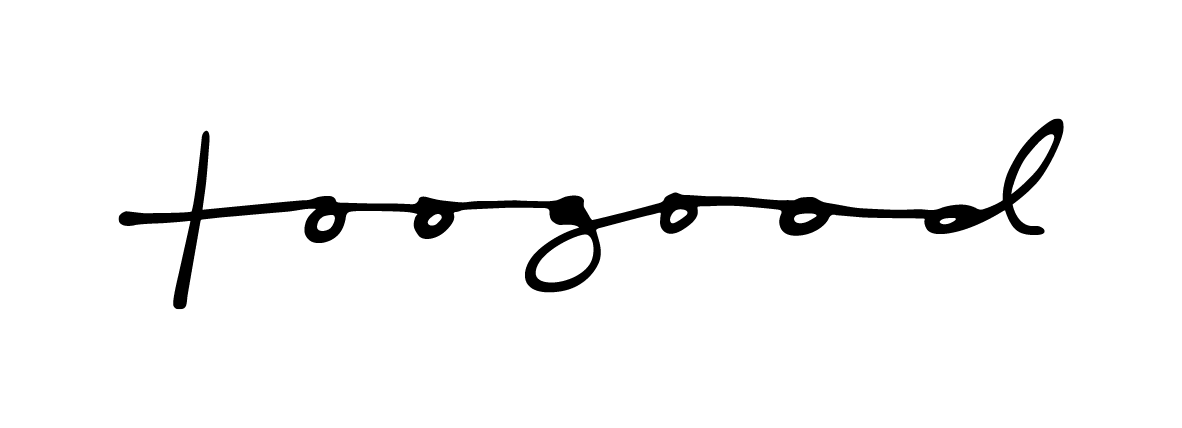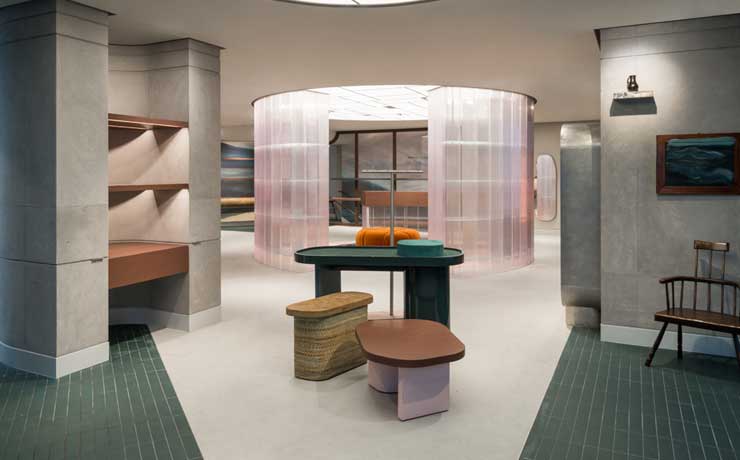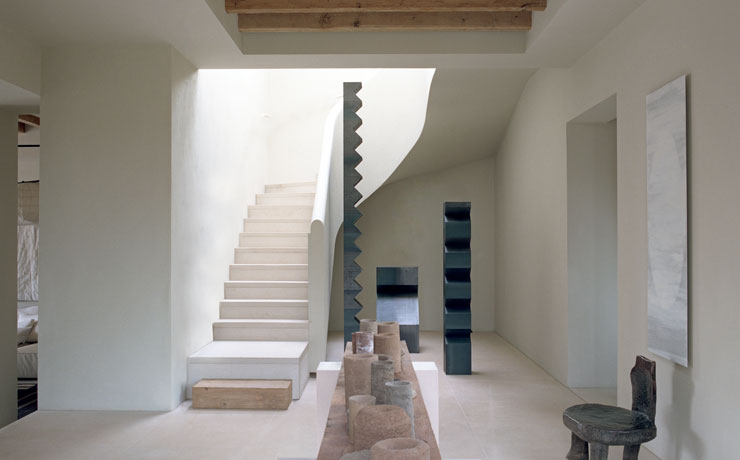PHOTOGRAPHY: PHILIP SINDEN
VOGUE LIVING
December 2020
Words: Annemarie Kiely
Photography: Philip Sinden, Tom Ross
It’s morning in the UK, evening in the eastern states of Australia, as designer Faye Toogood ‘Zooms’ her way in cross-continental conversation and speeding car through bucolic English countryside. It’s an impressive feat of lane-change in both thought and carriageway as she responds to the questions firing from the device fixed to her dashboard. “I did say that I’d be juggling,” she says, with apologetic glance to her smartphone’s screen. “But it’s night-time for you, so just sit tight and I’ll have you on my desk in about 10 minutes.”
As she negotiates the school drop-off, renegade drivers and a detailed explanation of her concept for the major installation commissioned by the NGV, Toogood, a mother of three who magics modern design poetry from an elemental primitivism, curses the ‘gotta-do-everything’ impact of Covid-19.
“It’s become so much worse during lockdown,” she says as she veers into the driveway of her home — a Victorian house, ringed by green fields, far from the industry of House of Toogood in East London’s artsy Shoreditch. “It’s like going back to the 1950s. Just another reminder of when it all goes wrong, how we [women] bear the brunt.”
She elaborates on the stress of it all while having to evolve her pre-Covid idea for the Triennial away from its presumptions about access to museum archives, manufacturing, people and funding, and explains how her concept quickly cast in a different light. “The NGV had bought one of my pieces for its permanent collection and [design curator] Simone [LeAmon] kept talking to me for a number of years about the possibility of a project — something similar to The Drawing Room,” she says of the sketchy autobiographical interior set within Somerset House that was the hit of the 2015 London Design Festival. “She wanted something along those experiential lines for the Triennial, using light as my theme.”
But it wasn’t going to include a chandelier, avows Toogood of her refusal to jewel up the allocated European salon, a room dressed with 17th-century Dutch masters that quietly allude to an age when reason shifted from superstition to science. No, the designer’s concept was to issue a counterintuitive riposte to set topic.
“I told them that I would like to work with the absence of light,” says Toogood, turning the engine off and remaining cossetted in the car’s bubble. “I particularly wanted to respond to those Dutch still-life paintings, the Rembrandt portraits and candlelit domestic settings of the time. That discussion extended into moonlight and daylight — the other light sources in art of the period. Pretty soon I needed three rooms not one.”
But all plans for a research trip to Australia were put on pandemic hold as Toogood pivoted to a remote response. She cast her eye over past creativity and matched bronze pieces, patinated in a celestial silver-nitrate, from her Assemblage 5 collection to the proposed Moonlight Room and made her Maquette 72/Masking Tape Light (2020) into a giant lunar orb seemingly fallen from its gravitational anchor in the night sky.
The Daylight Room, in contrast, was to dress with “a few of those amazing Dutch still-lifes of flowers,” Toogood says. “Blooms that would never naturally be together because the seasons would not allow.” She amplified their super-naturalism with neon light and commissioned large-scale tapestries (evocations of Daylight and Moonlight) to be made in Belgium’s famed Flanders Tapestries workshop from the collaged cut-ups of digital captures of details in the Dutch paintings. LeAmon describes the Daylight tapestry as a landscape littered with a rich symbology — an airborne white napkin encoding the then obsession with hygiene.
“The tapestries are a direct association with female work and feel like the first time that I have let my guard down,” explains Toogood, who has long been at pains to assert her female strength by steering clear of the decorative arts. “There is a softness and vulnerability within those salons that I haven’t exposed before, but now I see things a little differently.” This perspective shift is both a function of motherhood and the curatorial finding that Dutch women in the 1600s were confined to private domestic interiors to view art.
“This marked the rise of the salon movement,” says LeAmon in recall of the pair’s joint curatorial dive into the “magnificence” of the NGV’s European collection. “This was the moment when women became more engaged.” Toogood spot-lit this female captivation within the sanctity of a domestic context by dropping painting hangs down to a ‘homely’ eye level and adding her lithium-barium crystal Element table and Roly-Poly chair. Their precious clarity and construct repeats across Toogood’s curation of 17th-century glass vessels (pulled from the NGV archives) and crystallises the moment when ‘Golden Age’ science gave glass its brilliance.
The resulting scenography shimmers with subtexts on enlightenment and the evolution of humanism; one reaching crescendo in the Candlelight Room, where Rembrandt presides over portraits past and present. In its low-lumen glow, Toogood imagined the painterly faces of 17th-century Dutch nobles in dialogue with a 21st-century British family — effigies of her nearest and dearest, first idealised in bronze, but ultimately realised in the resource allowed by London’s Covid lockdown. “Amazon boxes, wood, car paint, plaster, canvas, literally anything I could get my hands on at the time,” says Toogood of ready-mades that LeAmon later likens to the papier-maché lumpiness of Franz West’s sculptures spliced with classicism.
These busts are the arresting best of a studio relay that saw staff adding and subtracting bits over 12-hour days to create a surprising whole. “I was so impressed with their way of working,” recalls LeAmon of her first meeting with Toogood and staff in 2015. “Faye is an exceptional genre-defying creative director who has nurtured a team that passionately practice her ethos.”
According to Toogood, all the forced reappraisal of process opened up her practice and brought an excitement and joy that fed into the painting of a 35-metre-long canvas scenography that templates the positions for portraits. “We could only approximate their placement in these tableaux and it will all likely be a bit imperfect,” she says. “But there’s a lot of beauty in that,” and a lot of illuminating thought on identity, gender, resource, strength and the surety that light persists in darkness. VL
The NGV Triennial runs from 19 December 2020 to 18 April 2021.
Read more about the NGV Triennial here.



